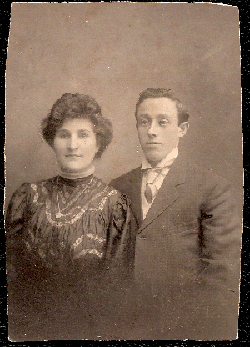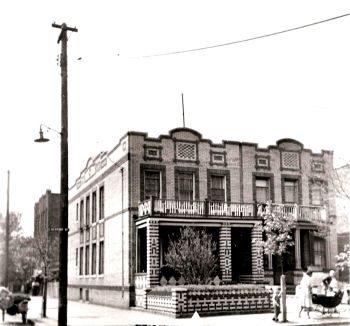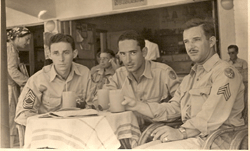
Samuel Drach was born August 29, 1884 in Wojnilow, Austria which was then part of the Austrian-Hungary Empire. His parents were Jacob Drach and Helen Shippar, although the spelling of her name is uncertain. A family member said that his mother died so it is also not clear whether Helen is his birth mother or stepmother. My father and aunt recall that grandfather said he left home at 13, but all the other documentation indicates he didn’t get to New York until 1903 or 1904. It is possible that 13 was the age he left his parents home because he didn’t like his stepmother, something that my aunt recalled him saying. However, I haven't been able to reconcile that with what he told a cousin, which was that he had "a very loving mother" who did not want him to go but insisted that he seek a better life. Grandfather said there was a fear of pogroms, but had never been directly affected by one. My father believes grandfather came from a big family, and left home because there were too many to support. Grandfather told one of his other grandsons that his family was very poor and that his mother would make a thin soup to keep everyone fed. When there was meat it was eaten first because everyone was so thrilled to have it. This became his lifelong pattern even in America. He always ate his meal followed by soup. He told my cousin of a sister of whom he was very fond, who I believe was Scheindel Drach, living either in Wojnilow or Bukaczowce. I have been able to identify one older brother for certain, Yehuda Moshe, born Dec. 2, 1873. He was also known as Leib -- Yiddish for lion -- a name that's often combined with the Hebrew Yehuda, because the lion is the symbol of the tribe of Judah/Yehuda. I came across his existence because one of his sons, Meir, entered a Page of Testimony in 1951 memorializing his death in the Holocaust. He listed Yehuda Moshe’s parents as Yaakov and Khana, the Hebrew variants of Jacob and Helen. While my grandfather came to America, Yehuda Moshe and his family appear to have left Galicia and moved to Gelsenkirchen in the Ruhr region of northwest Germany, north of Dusseldorf and near the Netherlands.
Yehuda Moshe married a widow, Rivka Nuesbaum, and they had four children. Two of them, David (born 1901) and Avraham (born 1902), were from Rivka’s first marriage. David had two children and Avraham had three, but both these families died in the Holocaust. Yehuda Moshe had two of his own sons with Rivka – Meir (born sometime between 1904 and 1910) and Shmuel (born 1908). Shmuel was born in Rozniatow (modern name, Rozhnyatov), about 20 miles from Wojnilow, but his permanent residence was Gelsenkirchen. During the time of the Nazis, Gelsenkirchen became a center of wartime industry and often the target of Allied bombing raids. Two synagogues in Gelsenkirchen were destroyed in the anti-Jewish riots of Kristallnacht on November 9, 1938. In the Kristallnacht Nazis in the German Reich destroyed Jewish business, dwellings and cemeteries, set synagogues on fire. Also the synagogue in Gelsenkirchen, which had been inaugurated in 1885, was burned down to the foundation walls. However, the Page of Testimony submitted by Meir indicates the family was at one point the Polish border town of Zbonzyn. It may be that he was taken there because histories of the Holocaust note that there was a Polish "Aktion" on October 28, 1938. Thousands of Polish Jews are rounded up and sent back Zbonzyn. Poland expelled all its German Jewish residents. In September, 1939, all Jewish men in Gelsenkirchen were deported to a concentration camp Sachsenhausen near Berlin. A German database of Jewish victims says that Avraham Nuesbaum, who was the son of Moshe Yehuda’s wife Rifka by a previous marriage, was sent there and also indicates at least several of the Drachs were sent to Riga, Latvia where there was a Jewish ghetto in 1942. There was a concentration camp outside Riga, where the Jews in Riga were probably sent for execution when the ghetto was liquidated. A German history says that in June, 1942, a gassing van that had been used in Zemun in Serbia for extermination of Jews there was sent to Riga for the same purpose. Shmuel married and had a daughter but they, too, perished in the Holocaust. However, Meir survived because he reached Israel in 1933. His older brother David was in charge of the list of giving the certificates - the papers which were the permission to enter Israel. A descendant of Meir's said that David gave his papers to his younger brother because he was "young and unmarried. For the rest of his life Meir felt very bad that he survived and his brother hadn’t.”
Meir immigrated to Israel in 1933 where he met his wife Rachel, and eventually settled in an Orthodox community named Bney Berak, outside Tel Aviv, and had two children.
Meir’s son Yehezkel changed the sound of the name from “Drach” to “Derech,” which in Hebrew means “way.” As far as I can tell, Meir is the only one of Moshe Yehuda’s family who survived the Holocaust. My grandfather immigrated to the U.S. at the age of 19 on February 21, 1904. He left from Hamburg aboard the Hamburg American line's steamer the Patricia. Even today, a car trip from Voynilov/Wojnilow to Hamburg is more than 800 miles and takes at least 15 hours. The Patricia, which traveled at a speed of about 13 knots, took 20 days to make the Hamburg-New York voyage. Hamburg was a major jumping-off point for Jews and other Eastern Europeans bound for America. A major reason was the work of Albert Ballin, himself a Jew, who had taken over from his father an emigration agency that arranged passage to America. He was also a director of the Hamburg America line, or Hapag, and he built a “city within the city” in Hamburg, named BallinStadt, to house emigrants who converged on Hamburg from all over Europe to take his Hapag shipping company’s liners headed for the New World. The original “city” comprised 30 one-story buildings and included a synagogue, a church, a hospital and cafeterias as well as a playground. Historians estimate that around five million people passed through BallinStadt. Eastern European Jews fleeing economic and religious hardship were especially attracted to Hamburg. In the Hamburg records, grandfather was described as a “Landmann, Tagelöhner.” “Landmann” is a peasant and “der Tagelöhner” is a day laborer. His accommodations on the ship were described as "Zwischendeck" – or, "between decks.” A Thai Jones wrote a book about his great-grandfather who also took the Patricia from Hamburg to New York about three months before grandfather did. Philip Steckler was born in 1875 Romny, Ukraine, a little over 400 miles from Wojnilow. The author described passage on the Patricia like this: That account matches other contemporary stories of the winter at the time Samuel Drach arrived. New York and the north in general, were enduring a bitterly cold winter. The New York Times reported on February 21, 1904, the day grandfather reached the city, that the steamship Coban arrived in Newfoundland after “a very bad passage and was obliged to steam south as far as Sable Island to escape the ice floes, which made her go 200 miles out of her course.” The Times also reported that “the winter of 1903-4 will go down in the history of railroading as one of the hardest ever experienced.” Upstate, many trains “had to be abandoned in many instances, and on the main line of the New York Central scarcely a through train has run on schedule time since the New Year came in.” On this date, the Times also reported about the high number of deaths in the city due to consumption. The secretary of the Charity Organization Society said this was due to low wages, unsanitary conditions in the home and at work, population density, intemperance, and exposure to dust, physical strain and excessive heat. The disease hit mostly at people between 15 and 45.
Like all immigrants, grandfather passed through Ellis Island. There were two others on board from Wojnilow, an Isaac Schachter and a Salomon Geller. Grandfather listed himself as a “laborer,” his language as Hebrew and he had less than $20 with him. Geller was also 20, listed himself as a “waiter,” spoke Hebrew, had $18 with him and was going to live with a relative, Chaskel Geller. Schacter was 19, a laborer, and had $11.
Grandfather told one of his grandsons that on his first day on the streets of New York he asked a big irish policeman for directions and was knocked to the ground by him. He got work as a tailor's apprentice and slept on the floor of the shop. He showed up six years later in the 1910 Census in what was then known as Manhattan’s 11th ward on the lower East Side with a family named the Eberts – Abraham, wife Annie, and children Pauline and Mollie. Abraham was the brother of the woman my grandfather would marry, Anna, and he had a brother Louis, born about 1878, whose wife was named Rose. Abraham Ebert had emigrated to the U.S. from Bukaczowce, which was about 8 miles from Wojnilow. He died in 1932 at the age of 62 and is buried at Mt. Zion Cemetery. The 1900 Census says Abraham was born June, 1869 in Galicia and that he emigrated to the U.S. in 1888 and that his occupation was “soda water.” Abraham and Louis appeared to be together in the seltzer business. My father remembers Louis coming by my grandfather's house in Brownsville/East New York in a cart drawn by two hourses, and he'd give my father a ride while making deliveries. The parents of Abraham, Louis and Anna were Mordechai and Neche Ebert (neé Kleinfeld), although Anna anglicized this to Marcus and Norma on her Social Security application. They lived in Wygoda (which Anna also spelled as “Vigoda”). There are many Wygodas in Galicia but I believe the Eberts lived in the one about 72 miles from Wojnilow. They owned an inn near the railroad station in their town (coincidentally or not, “Vigoda” means inn or tavern, and Jews were the ones who frequently ran them). They had at least three other children: Luzer, probably Abraham's brother Louis; Danil,born in 1880 and who died at the age of 20 days, and Nattan, born 1887. Anna, my grandfather's wife, was born May 18, 1888 in Poland. An aunt of mine recalls that Anna originally came to New York, around 1903, not to immigrate, but on vacation, presumably to visit her brothers. Her parents had given her $25 to take on the trip. Samuel and Anna were married May 20, 1908, (he identifying himself as “Sam” and she as “Hena,” although others also knew her as “Hencha.”) At the time, grandfather was living at 177 Stanton Street and grandmother at 278 3d Street, about 6 blocks away from each other on the lower East Side near East Houston Street. There were two witnesses: a Markus Schreiber (there is a record of a Markus Schreiber arriving in New York in 1906 at the age of 19, from a town in Poland called Oleszyce, about 100 miles from Wojnilow) and a David Adler.
Sam and Anna moved to East Flatbush in Brooklyn. After their first child Helen was born in 1910, Anna took her back to the old country to visit her parents. On the return from visiting her parents, Anna had several travelers accompanying her. Linda Cantor, another member of JewishGen, who also had family in Bukaczowce, told me her grandmother Henia and her twin sister Pesha (both Mandels) were put in Anna’s care because their mother did not want them travelling alone. Henia, a seamstress, and Pesha went to live with a cousin in New York.
The connection between the Mandels and Eberts was through Freeda Ebert, wife of Abraham Mandel, the first cousin of Linda Cantor’s grandmother. Freeda was the anglicized name for “Friede” or “Freitcha.” Linda says Freeda was known to her family as “Mime Friesha.” I do not know Freide’s relationship to my grandmother, Anna. Freeda died Feb.6, 1919 at the age of 49, as a result of the influenza epidemic that began in 1918. Her daughter, son-in-law and grand-daughter also died in the epidemic, two of them on the same day as her. The Hebrew date of their deaths was 7 Adar, which is a very special day in the Jewish calendar because it is the traditional birthday and death day of Moses. Linda pointed out another link between our families. She asked, "Did Anna and Sam have a restaurant on the Lower East Side?" Sam, in fact, did have a restaurant listed in the 1915 New York City directory as being at 10 Delancey Street. It was described as a "subway lunch room" in a later directory, and in fact, was at the Manhattan terminus of the then privately-owned Brooklyn Rapid Transit Company. But the line had been extended up to Chambers Street in 1913 and my father recalls that this was the beginning of the end for the business. The family moved to Brownsville, living in a house on Newport St. which dead-ended at an elevated subway. Under the El was a slaughterhouse where he would buy chickens, a pickle factory and a smokehouse for fish. After the restaurant went under, Aunt Helen became the breadwinner for the family, working as a bookkeeper for a company that made woolens, called “Shapiro and Brownstein.” Sam, now a waiter, often went from job to job, because he usually only worked special weekend occasions for big affairs, including hotels that were then in Manhattan Beach and Brighton Beach, where he could take home $300 or $400. Grandfather was very much a union man and vocal about his politics, being a staunch Democrat. He greatly admired President Truman and considered the Republicans to be anti-Israel, and particularly hated John Foster Dulles, President Eisenhower's Secretary of State. He had a nephew, Israel Drach, who owned a pharmacy in Bayonne, N.J. and later changed his name to Drake. Israel, born in 1897 and died in 1988, came to the U.S. in 1920, via Liverpool, aboard the ship Celtic and the manifest said he intended to stay with his "Uncle Sam," using the address of grandfather's restaurant at 10 Delancey St. He had a genius son, Alvin Drake, who attended MIT at an early age and taught there for 36 years.Israel apparently spent his last years with or near Alvin, since his place of death was Cambridge, Mass. Both Israel and his wife were buried at Mt. Hebron Cemetery, Queens, in the Chevra Ohev Shalom Anshei Bukaczowce section. Israel also had another son, Jerome, who died in 2010. In the early 1940s, Anna went blind. Sam’s co-workers would often tell him, after an affair he had workedwas over, that they would clean up, and he should go home, because they knew his wife was blind. He would only work on weekends.He was able to make enough money on those two days to stay at home and care for his wife during the week. I was 31 when Sam died in 1979. Anna had passed away seven years earlier. He never said much to me about his past, other than fondly recalling the Emperor Franz-Josef. But more than that, he never said much at all to his own children, or at least little my father knew about. When my father was in the Air Force during World War II, and he was going to be in Tel Aviv, my grandfather told him to look up a nephew which my father did. That nephew was Meir, but when I started this research, my father had remembered neither his name or what the relationship was, other than that Meir lived in a small hut with two children. Nor did my grandfather appear to have said anything about the fate of his older brother and his older brother's family, though he must've known because Meir's descendants told me they kept up a correspondence. One of Meir's children remembers the visit of an American relative and she also knew that my grandfather was caring for a wife that had gone blind. My discovery of these things was all new to my father. Copyright © 2009 Bruce Drake
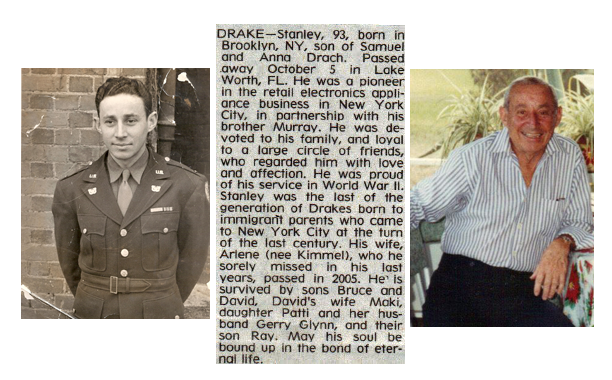
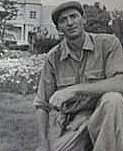

It was a late December day when he clutched his ticket and climbed uncertainly up a narrow gangplank of the steamer Patricia. The ship's great black stack burped out a breath of coal smoke, and her twin screws started churning the greasy waters of the River Elbe. Philip leaned over the rail or, unused to the motion, lay in his berth as the vessel gathered way toward two European stops -- at Boulogne and Plymouth -- and then the open ocean.
Patricia was one of the Hamburg-American Line's newest steamers, built a few years earlier with room for nearly 2,500 passengers. She offered a luxurious crossing for the lucky few who could spend at least fifty dollars for a private cabin. The remaining four-fifths, almost certainly including Steckler, settled for third-class berths on the lower decks, where they slept in bunks and ate in a common mess. At an average speed of thirteen knots, the passage, even during the rough winter months, was scheduled to take twenty days. Steckler's trip was marred by head winds and heavy seas, including a tidal wave that staggered the ship just as she was entering the Atlantic. Even Captain Reessing, a mariner with more than twenty years of salt in his blood, was rattled by the storm. "I have not known such weather for many years," he said. "The winter of 1882 was very similar to this, but none since then has been nearly so bad."

